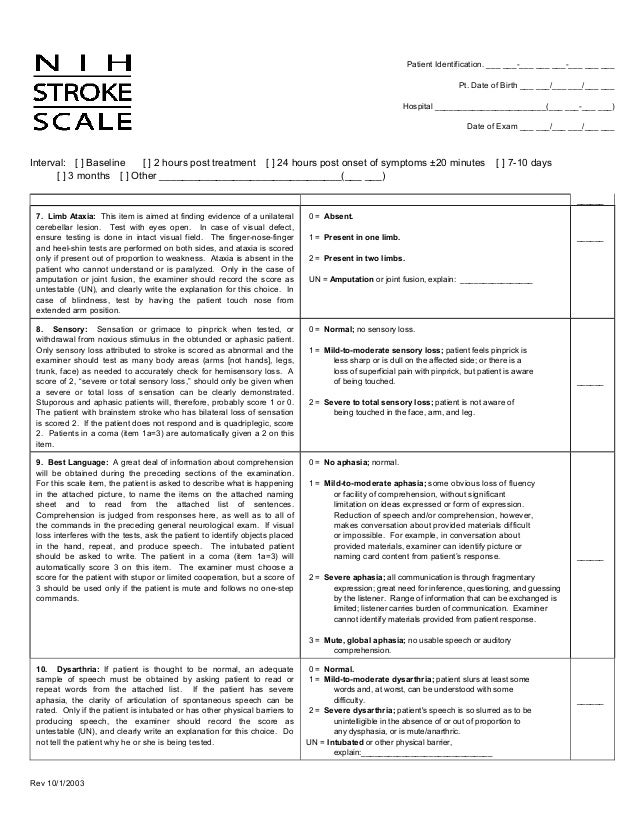The NIH Stroke Scale is an important tool used in the assessment and evaluation of patients who have experienced a stroke. This scale, developed by the National Institutes of Health (NIH), is widely recognized as a valuable tool for healthcare professionals to quantify the severity of a stroke and monitor the patient’s progress during the recovery process.
NIH Stroke Scale
 The NIH Stroke Scale consists of a series of neurologic assessments that evaluate various functions of the brain and nervous system. These assessments are conducted by healthcare professionals, typically nurses or physicians, who are trained in using this scale to evaluate stroke patients. The scale comprises 11 different components, each assessing a different aspect of neurologic function.
The NIH Stroke Scale consists of a series of neurologic assessments that evaluate various functions of the brain and nervous system. These assessments are conducted by healthcare professionals, typically nurses or physicians, who are trained in using this scale to evaluate stroke patients. The scale comprises 11 different components, each assessing a different aspect of neurologic function.
Assessing Neurologic Functions
 Some of the components of the NIH Stroke Scale include evaluating the patient’s level of consciousness, ability to understand and express language, visual fields, facial movement, arm and leg strength, coordination, and sensory perception. Each component is scored on a scale of 0 to 4, with 0 representing no impairment and 4 indicating severe impairment.
Some of the components of the NIH Stroke Scale include evaluating the patient’s level of consciousness, ability to understand and express language, visual fields, facial movement, arm and leg strength, coordination, and sensory perception. Each component is scored on a scale of 0 to 4, with 0 representing no impairment and 4 indicating severe impairment.
Interpreting the Results

Importance of the NIH Stroke Scale
 The NIH Stroke Scale plays a vital role in stroke care by providing a standardized and objective measure of the patient’s neurologic function. This scale is widely used in clinical practice and research settings to assess the effectiveness of treatments and interventions for stroke patients. Additionally, it allows for better communication and collaboration among healthcare professionals involved in the care of stroke patients.
The NIH Stroke Scale plays a vital role in stroke care by providing a standardized and objective measure of the patient’s neurologic function. This scale is widely used in clinical practice and research settings to assess the effectiveness of treatments and interventions for stroke patients. Additionally, it allows for better communication and collaboration among healthcare professionals involved in the care of stroke patients.
Utilizing the NIH Stroke Scale
 Healthcare professionals who use the NIH Stroke Scale undergo specialized training to ensure accurate and reliable assessments. This training involves familiarizing themselves with the components of the scale, understanding the scoring criteria, and practicing assessments on simulated patients. By mastering the use of the NIH Stroke Scale, healthcare professionals can provide optimal care to stroke patients and contribute to improved outcomes.
Healthcare professionals who use the NIH Stroke Scale undergo specialized training to ensure accurate and reliable assessments. This training involves familiarizing themselves with the components of the scale, understanding the scoring criteria, and practicing assessments on simulated patients. By mastering the use of the NIH Stroke Scale, healthcare professionals can provide optimal care to stroke patients and contribute to improved outcomes.
Resources for Learning the NIH Stroke Scale
 There are various resources available to healthcare professionals who wish to further their knowledge and understanding of the NIH Stroke Scale. Online courses, workshops, and educational materials provide in-depth information about the scale and offer opportunities for practice and skill development. These resources enable healthcare professionals to confidently and accurately utilize the NIH Stroke Scale in their clinical practice.
There are various resources available to healthcare professionals who wish to further their knowledge and understanding of the NIH Stroke Scale. Online courses, workshops, and educational materials provide in-depth information about the scale and offer opportunities for practice and skill development. These resources enable healthcare professionals to confidently and accurately utilize the NIH Stroke Scale in their clinical practice.
Advancements in Stroke Care
 The NIH Stroke Scale is just one tool in the vast array of advancements in stroke care. Ongoing research and innovations are continuously enhancing the understanding and management of stroke, ultimately leading to better outcomes for patients. From innovative treatments to advanced rehabilitation techniques, healthcare professionals are dedicated to providing the best possible care to stroke patients at every stage of their recovery.
The NIH Stroke Scale is just one tool in the vast array of advancements in stroke care. Ongoing research and innovations are continuously enhancing the understanding and management of stroke, ultimately leading to better outcomes for patients. From innovative treatments to advanced rehabilitation techniques, healthcare professionals are dedicated to providing the best possible care to stroke patients at every stage of their recovery.
Conclusion

Sources: